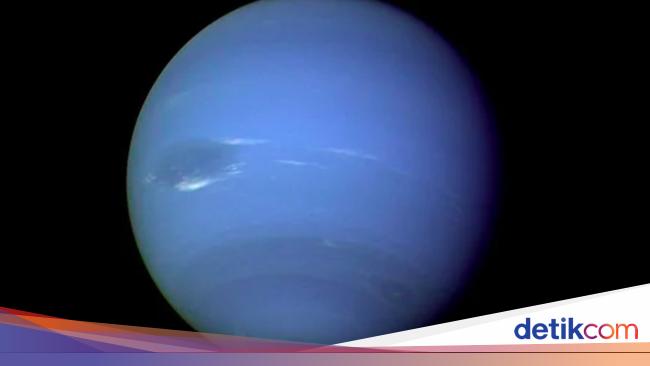Jakarta –
After the sun was formed, planet-planet itu then formed from the rest of the gas and dust that formed the Sun. Although each planet is unique, there are planets in the Solar System that have similarities and we can group them according to their composition.
In the Solar System, we generally recognize terrestrial planets or planets with a composition similar to Earth in the inner Solar System. These planets we know as rock planets. Included in this category are Mercury, Venus, Earth, and Mars.
The further away, the planets revolving around the Solar System get bigger. Much bigger than a rock planet. The composition is also similar in that it is formed from gas. Therefore, the planets such as Jupiter, Saturn, Uranus, and Neptune, are classified as giant planets.
So, how can these planets have similarities and differences? Apparently, this has to do with the location where the planet was formed.
After the Sun was formed and the material in the protoplanetary disk interacted to form planets, there were planets that formed near the Sun and some were far from the Sun. Keep in mind that the Sun is very hot, and the further away you are from the Sun, the colder it gets.
As a result, volatile substances, which evaporate easily at normal temperatures and pressures, cannot condense at high temperatures near the Sun. As a result, gas and ice evaporate.
In this area, silicates and metals can withstand high temperatures and these materials dominate areas of the Solar System and form rocky planets such as Mercury, Venus, Earth, and Mars.
The further away, the colder the temperature so that volatile substances such as gas and ice can survive. In this area, rock, metal, and ice combine to form a solid core which then pulls gas around to form a giant gas envelope. Eventually, giant planets with thick gas atmospheres dominated by hydrogen and helium, such as Jupiter and Saturn, formed.
At first, the gas giant planets also included Uranus and Neptune. However, as the composition of Uranus and Neptune became known, it turned out that these two planets were actually composed of elements heavier than hydrogen and helium. Located far from the Sun, the material that makes up the two planets is no longer a liquid or gas. Uranus and Neptune consist of heavy elements such as oxygen, carbon, nitrogen, and sulfur, in the form of ice. This means that this chemical compound has a very low temperature and reaches its freezing point. Therefore, Uranus and Neptune are categorized as ice giant planets.
Because in the past we only knew the planets in the Solar System, the planetary system model that was built would be like the Solar System. So, planets that form near stars are rock planets, while those that are far from stars are giant planets. It turned out not to be so.
Exoplanets or planets orbiting other stars have a different story. We even have different kinds of planets.
In 1995, when exoplanets were first discovered orbiting a sun-like star, different types of planets were discovered.
Planet 51 Pegasi b orbiting the star 51 Pegasi is a hot gas giant planet. Surprisingly, the planet is near the star. So close, this planet only takes 4.2 days to orbit its star. Even more interesting, planets like this are often found in exoplanet systems or planetary systems on other stars.
How do gas giant planets form near stars?
It appears that these planets formed in the outer regions of the star system or the outer regions of the protoplanetary disk and then migrated to areas within the system. There are two guesses when this hot gas giant planet migrated. The first was in the early stages of system formation when the planet was young. The second is when the planets are unstable and the resulting interaction throws a gas giant planet close to the star.
The hot gas giant planets near this star are classified as Hot Jupiters.
Turns out it’s still there tipe planet others that do not exist in the Solar System. This planet was discovered in 2005 around the star Gliese 876. Interestingly, this planet is larger than Earth, but smaller than Neptune. This planet is known as the super planet Earth.
Although not in the Solar System, super-Earths are one of the most common planets found in exoplanet systems.
However, not all super-Earths are rock planets. There is a planet that is dominated by hydrogen and helium gases and is categorized as a mini Neptune planet.
To distinguish which is rock and gas, it can be seen from their density. If the density is low, then the planet is dominated by hydrogen and helium gases, while if the density is high, it can be ascertained that the composition is rock or metal.
There are two theories for the formation of super planet Earth. First, superplanets Earth forms very quickly near stars. For that it takes a very large mass that is near the star to be able to form a super planet Earth. And second, super-Earth planets formed far from their parent star and migrated closer to the star.
From existing theories, it can be concluded that the mini planet Neptune formed beyond the frozen line and migrated near the star. Interesting don’t know tipe planet in a large family?
This article is a collaboration between detikEdu and Langit Selatan. The entire content of the article is the responsibility of the author.
Watch the video “Ciamis Lacks Thousands of Teachers, A Number of Schools Filled With 2 ASN Teachers“
[Gambas:Video 20detik]
(gas / gas)
–


